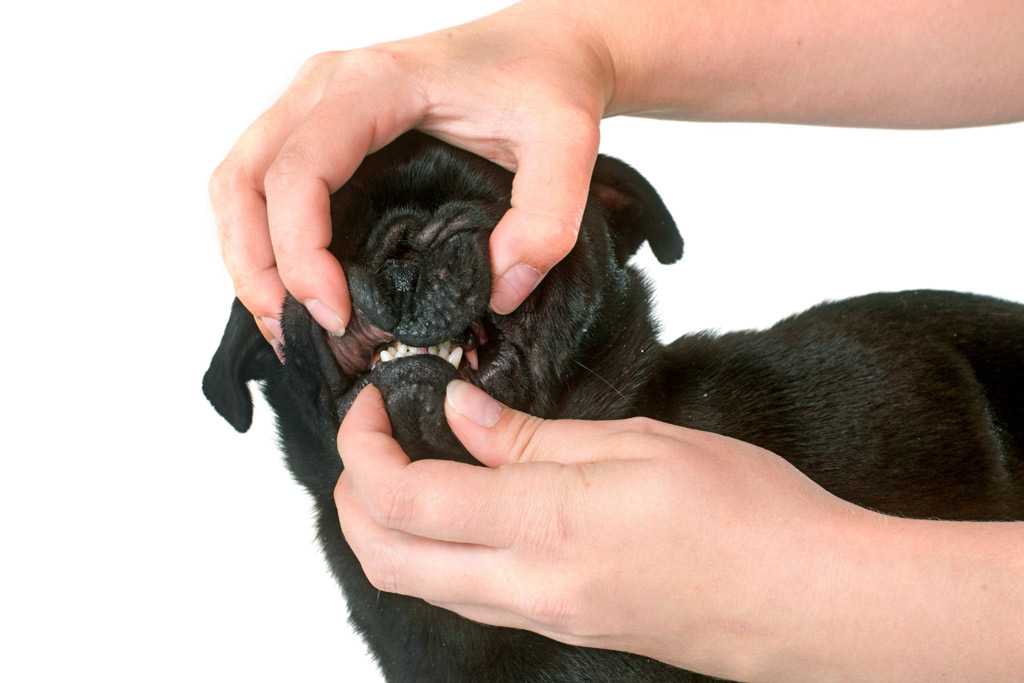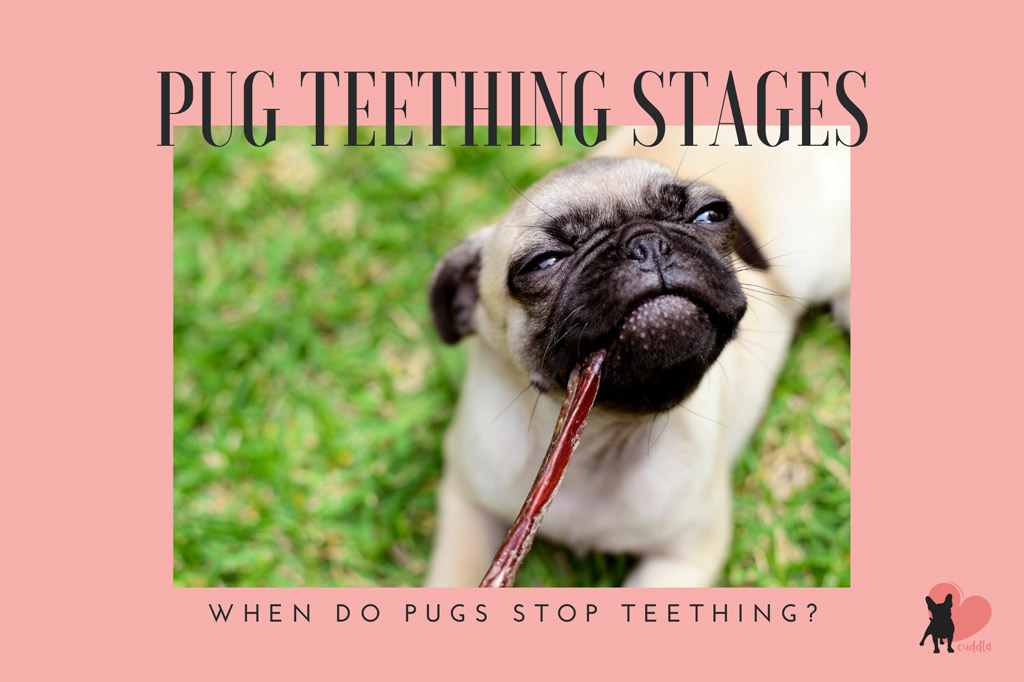
Pug puppy teeth might be small, but they are needle sharp! If your Pug is teething and chewing through everything, you may spot some blood drops on toys and teeth on the floor.
Don’t be alarmed, this is totally normal and part of the teething process.
Pug puppies go through teething twice by the time they are 1 year old. Puppies get their 28 temporary teeth when they are 2 to 4 weeks old. These fall out between 8 and 16 weeks, and adult teeth start coming out. Pugs stop teething when they are 6 to 8 months old, after getting their 42 adult teeth.
To understand what your pup is going through and what you can do to help, let’s go through a Pug’s teething stages! 😉
Pug Teething Stages
From newborn until they are 2 weeks old, Pug puppies are blind, deaf and toothless, i.e., newborn pups do not have teeth.
However, that starts to change after the first two weeks.
Here are Pug’s teething stages (source):
Weeks 2 to 4: Pug Puppy Baby Teeth Comes Out
By week 4, all of your Pug puppy’s baby teeth should have come out.
In total, Pug puppies usually have 28 baby teeth, also known as deciduous teeth, baby teeth, temporary teeth or milk teeth. Basically, it’s not your Pug’s permanent set of teeth.
Unless you are a breeder, you don’t need to worry about this first teething stage since your Pug pup is with his mother and siblings, at the breeder’s home.
Weeks 4 to 8: Pug Puppy Inhibited Biting Starts
During the age of 4 to 6 weeks, the inhibited biting starts. Pup puppies will start to learn bite inhibition along with their siblings, under the supervision of their mother.
Inhibited biting means the puppy developing and learning how to control the strength of his bite, also sometimes referred to as soft mouth.
If your puppy stayed with his mom and littermates until he’s 8-10 weeks old, he will usually have learned more appropriate social behaviour and bite inhibition.
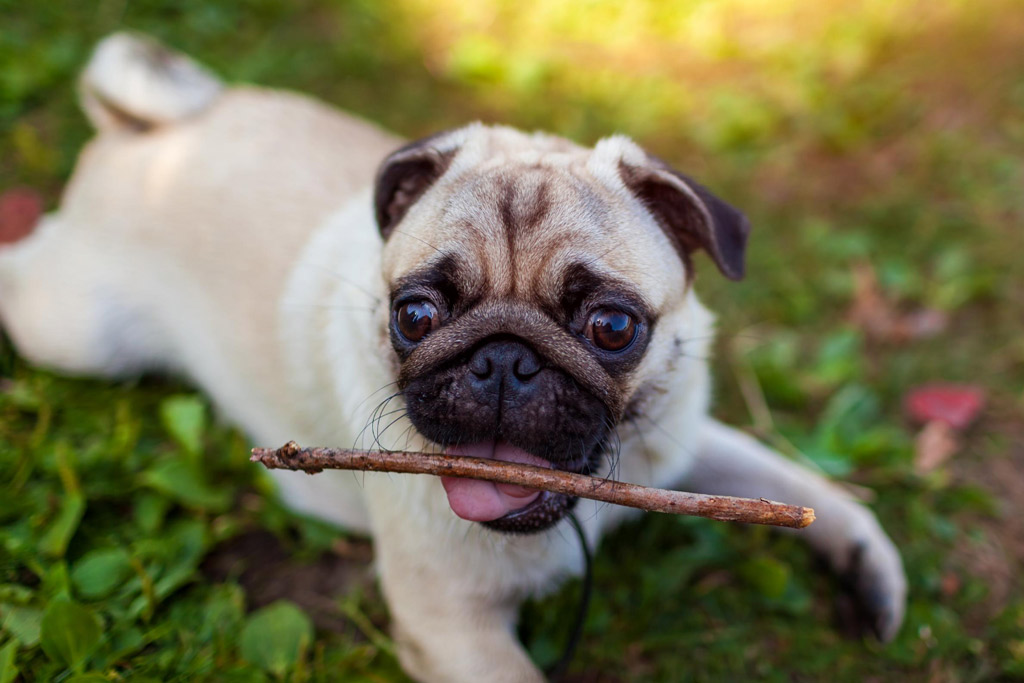
Weeks 8 to 16: Pug Puppy Starts to Loose Milk Teeth
Between 8 to 16 weeks of age, your Pug pup will start to lose his milk teeth.
“At about 8 weeks of age, your pup will start to lose his deciduous teeth. The roots resorb and the new adult teeth will push their way up through the gums.”
Dr Debra M. Eldredge, DVM, in New York (source).
During this stage, you will find rice-sized teeth around your house as your pup starts to shed his temporary teeth. Also, you can find blood spots on his toys.
This phase plays a big role in bite inhibition and decreasing mouthiness. It’s a good time to start gradually touching your puppy’s mouth, outside and in. By doing this, your Pug will assimilate your behaviour as normal.
This will allow you to introduce your pup to a toothbrush and toothpaste next and finally start brushing his teeth. This is where Nylabone Puppy Dental Dinosaur Chew Toy can help you keep your dog’s teeth clean and its massaging nubs will ease his gums.
3 to 6 Months: Pug Puppy Teething Phase
At 3 months of age, your puppy loses his first set of teeth (his baby teeth).
Here’s the order in which your Pug will lose his temporary teeth and get it replaced by the permanent ones (source):
- Incisors, i.e., front teeth (3 months old).
- Molars (around 4 months old).
This process is painful for your pup, so be patient and check the 3 Tips to Stop Pug Chewing and Nipping section below for some tips!
When your pug puppy is about six months old, all of his puppy teeth should have fallen out, and his adult teeth should have started growing.
6 to 8 Months: Pug Puppy Stops Teething
When do Pugs stop teething?
By 6 to 8 months old, Pugs stop teething after all of their adult teeth (42 in total) are out. Pugs can teeth for 6 months, but they should stop by the time they are 8 months old.
The good news is that your Pug has stopped teething. The bad news is that if you haven’t taught your pup not to nip you and chew your stuff, this is only going to get worse. If 28 baby teeth can cause damage, imagine what 42 adult teeth can do!
Continue reading for some tips on how to deal with chewing and nipping behaviours.
Finally, if you see that your Pug puppy still has puppy teeth at this stage (especially around the 8 months mark), check with your veterinarian.
“Some breeds are prone to issues that can prolong the typical teething process. In some cases, the dog’s baby teeth are slow or resistant to falling out, sometimes even requiring intervention by a veterinarian.
Technically, those dogs haven’t fully gone through the whole teething process. That does tend to be somewhat breed dependent. We see it more in small breeds of dogs and brachycephalic breeds.“
Jennifer Coates, DVM, in Fort Collins, Colorado.
Read also: When Are Pugs Full Grown? [Growth Chart Included] to know what to expect on each of your pup’s growth stages!
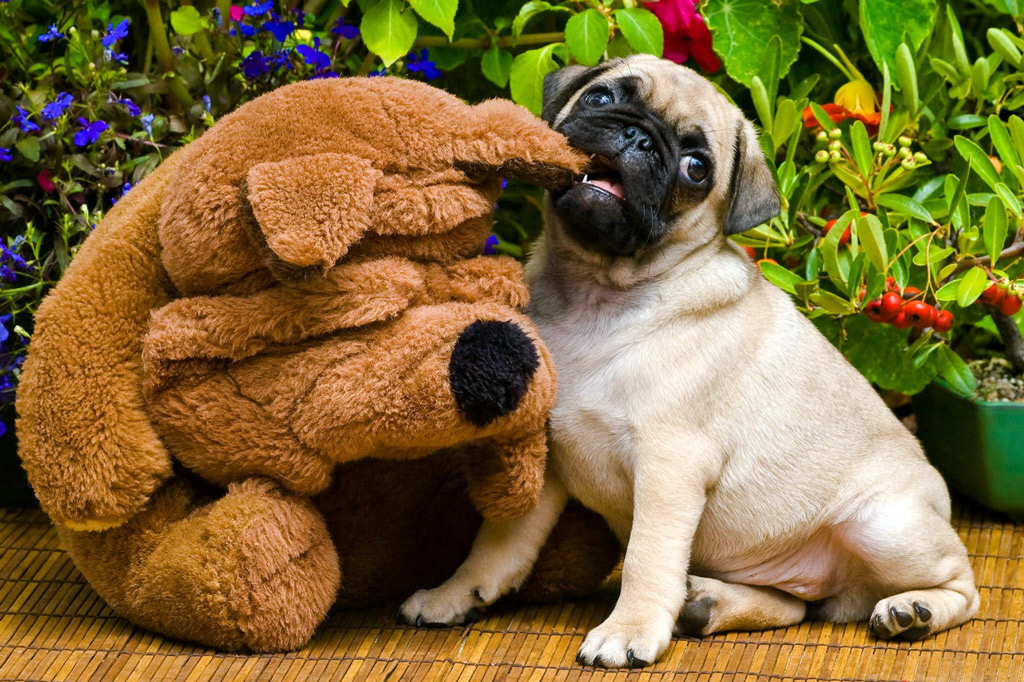
Pug Teething Signs
You might have realized that your Pug puppy is teething because he’s chewing through your house!
During the teething stages where the baby teeth are replaced by adult teeth, your dog’s gums become sensitive and inflamed. Your puppy will seek to soothe his discomfort by chewing.
Here are the most common teething signs that you should be aware of:
- Fallen baby teeth: One of the most obvious signs that your puppy is teething is finding those little milk teeth on the floor.
- Blood spots: Little blood drops on toys is also a common sign. Since chew toys provide pain relief during teething, it’s likely that you find blood spots on them.
- More drooling: Teething puppies will drool, so you can expect more saliva than usual.
- Lots of chewing: Chewing during teething is a way to relieve pain. So, your pup is likely to chew even more. This is when chew toys come in handy. 😉
- Sore gums: Red, inflamed gums.
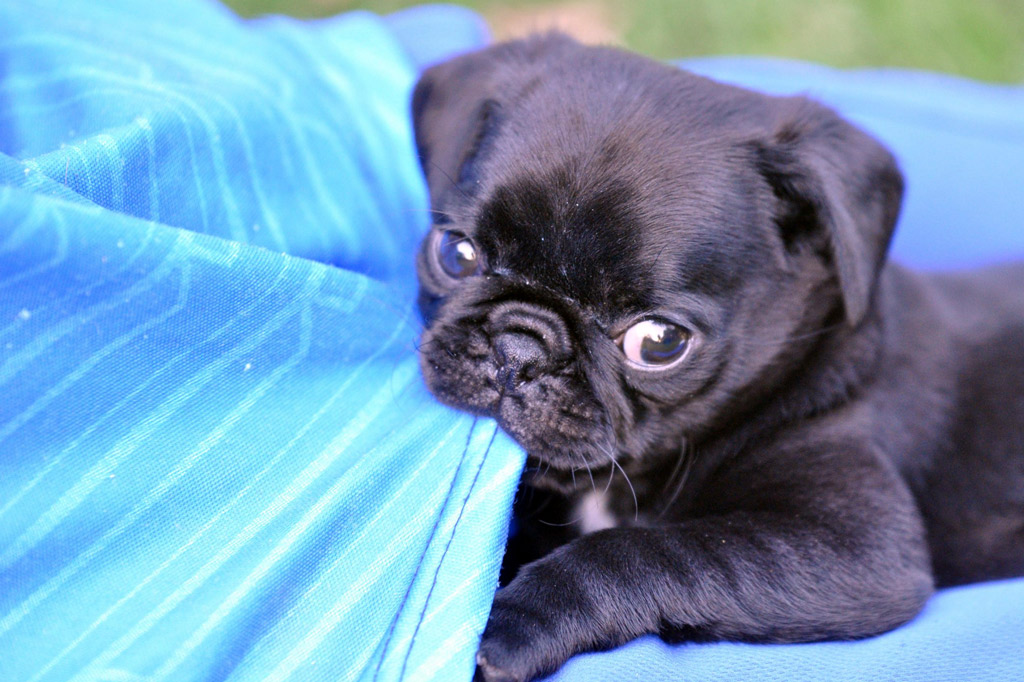
3 Tips to Stop Pug Chewing and Nipping
During teething, you want to teach your Pug puppy about bite inibition, give him an appropiate chewing outlet and relief his pain and sore gums.
Here’s how you can do those three things:
#1 – Teach Your Pug to Stop Nipping (Bite Inhibition)
Between 3 to 6 months of age, adult teeth start coming out and your pup will begin chewing. Most puppies tend to be “mouthy” during the “Ranking Stage.”
This is the stage that concerns you.
Now it’s your turn to teach your pup what the house rules are and that biting is not allowed. It’s important that your Pug pup learns to inhibit his bite.
The sooner you teach your Pug, the easier it is to guide your pup not to nip and bite during play and when excited. When he gets older and biting becomes harder, it becomes more difficult to stop it.
Read also: How to Stop Boston Terrier Nipping – although I wrote this post thinking on Boston Terriers, the same principles apply to Pugs.
#2 – Provide Puppy Chewing Toys to Your Pug
For adult Pugs, chewing keeps their jaws strong and their teeth clean. Plus, it also combats boredom and can relieve mild anxiety or frustration.
But for Pug puppies, chewing is a way to relieve pain caused by teething. So, a great way to prevent nipping is to provide chew toys like Kong Puppy Goodie Bone and Nylabone Puppy Chew that are appropriate for puppies’ teeth.
Basically, they are made with tough but safe rubber that will keep your pup away from chewing anything else!
When choosing a chew toy, your Pug’s age is a key consideration:
- From 8 to 16 week of age: Your pup still has his baby teeth. He needs toys with softer rubber or plush toys.
- From 3 to 8 months: Your puppy will be teething, so avoid hard rubber. To help him cope with the pain and discomfort, have a good variety of chew toys that will keep him distracted from chewing everything else!
- After 9 months: Once the teething phase is over, your Pug will have a strong enough jaw for harder rubber toys, depending on him being an average or extreme chewer. Also, you can focus his endless energy by playing with balls or tug toys.
P.S. Use my favourite dog toys guide for toys and game ideas to enjoy with your Pug!
#3 – Make Frozen Treats for Sore Gums
Cold and frozen toys and treats are other options to soothe your puppy’s gums.
You can freeze a stuffed Kong for puppies with some banana, carrots or blueberries.
Alternatively, you can give your Pug a Nylabone Chill & Chew Freezer Dog Bone or Multipet Chilly Bones Teething. A cheaper option is to put a handful of ice cubes in your Pug’s bowl!
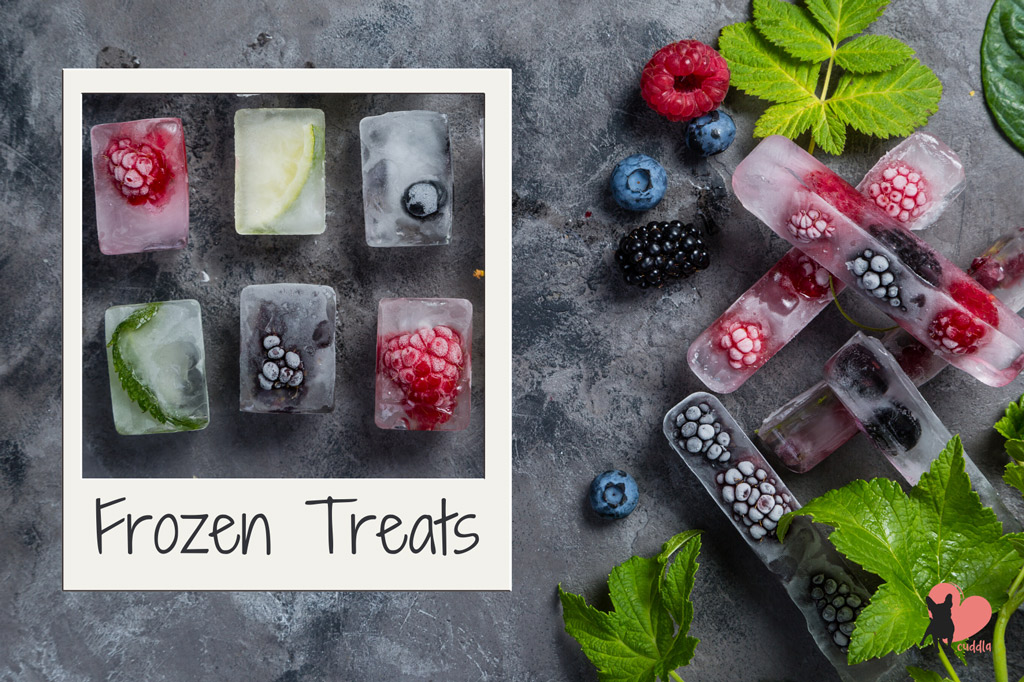
Pug Dental Health
The bite set you see in your puppy may change as your pooch matures. Many Pugs are born with a level bite (the upper incisors and lower incisors meet edge to edge).
So, after all those 42 teeth are out… how should your Pug’s bite look like?
Pug’s Bite Set
According to AKC breed standards, a Pug’s bite should be very slightly undershot. This means that Pugs have an underbite: their lower jaw extends out slightly more than their upper jaw.
During development, watch out for your Pug’s bite and if your Pug develops a noticeable (i.e. pronounced) underbite, you should take him to the vet for an assessment.
Any sort of misalignment or fitting of the teeth, also known as malocclusion, can affect chewing and lead to issues with jaw discomfort.
Brachycephalic dog breeds like Pugs have a normal malocclusion because their lower jaw is slightly longer than the upper. But, you should check with a vet to make sure that your Pug won’t suffer from any issues in the future.
Also, a dog’s bite set is a genetic trait, and your Pug would have genetically inherited his parents’ bite set. So, you should be able to know your Pug’s history if you got your puppy from a reputable breeder.
Pug Dental Issues
According to the American Veterinary Dental Society, over 80% of dogs have some kind of dental issue by age 3. As a result, these dogs will very likely have some early evidence of periodontal disease.
Are Pugs prone to dental issues?
Yes. Both toy-sized breeds and brachycephalic breeds are prone to dental issues, including tooth decay.
If dogs have 42 adult teeth, depending on how big their mouth is, they will have more space to accommodate them. The mouth of a pug is not as big as a Labrador, for instance. So their teeth will be more cramped, even if their teeth size is smaller.
When teeth are crammed together, with little room between them, this can make them more prone to the development of plaque. For the same reason, cleaning that plaque off can be more difficult.
It starts with plaque that hardens into tartar and progresses to infection of the gums and roots of the teeth.
This is where pet insurance becomes important for ensuring your Pug’s health at all times. My recommendation is Petplan pet insurance, who cover a wide range of veterinary treatments for dogs, including dental treatments.
Apart from periodontal disease, Pugs can suffer from other dental problems including:
- Gum disease.
- Halitosis (bad breath).
- Gingivitis.
- Tooth fractures.
So, what are the warning signs to look out for?
- Bad breath.
- Excessive drooling.
- Swollen or bleeding gums.
- Loose or missing teeth.
- Excessive tartar build-up (you are not able to clean it).
If you notice any of these symptoms, pay a visit to your vet.
Insider Tip: Brushing your Pug’s teeth is probably the most effective way to prevent dental disease, bad breath, and tooth decay.
